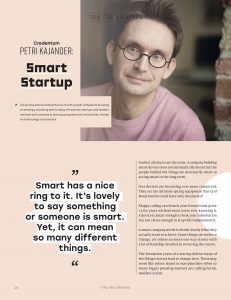
Smart has a nice ring to it. It’s lovely to say something or someone is smart. Yet, it can mean so many different things.
But not all smarts are the same. A company building smart devices does not automatically mean that the people behind the things are necessarily smart or acting smartly in the long term.
Our devices are getting ever more connected. They are the ultimate spying equipment that Q of Bond movies could have only dreamed of.
Sloppy coding can breach your firewall and privacy for years without most of the users ever knowing it. The device is smart enough to leak your information but not clever enough to stop it independently.
A smart company needs to think closely what they actually want to achieve. Some of the things are easier to change yet others are more one-way streets with a lot of hardship involved to reverse the course.
The forming years of a startup define many of the things that are hard to change later. They may seem like minor issues or non-priorities when so many big pressing matters call for immediate action.
Yet, the silent ones can be either fatal or at least heavy hitting issues later on. My top favourites are business model, culture and people.
Companies’ business models say cloud and clear what they are really doing. It’s hard to deny something that is a necessity for your revenues. Google and Facebook are examples where you, the user, are the product. They are information hungry for a very good reason. It’s the money making machine.
In comparison, Apple is primarily profiting from selling devices and hence there is more credible claim of aligning with user privacy and letting users be in control of their information.
The tide is changing from centralised top-down hierarchy of data collection to user powered and controlled decentralised model. People are getting wearier of data breaches and the leaks can have dire consequences due to cheaper data mining, mass handling and surveillance.
Culture is something that happens anyways. You have a culture whether you consciously are aware of it or not. Often, the first people in a company define by their own actions and values the way things are done in the future. Culture eats strategy for breakfast. Once something is a habit it’s difficult to change it.
Nice statements have very little relevance if your performance goals and required results conflict them. Incentive structures are powerful tools that shape your culture, for better or worse.
This leads to the most crucial component: the people. Values and integrity define the outcomes. If you have a culture where long-term business relationship with clients is of upmost important it shows in the user experience and quality of the products. And all these start and end with your people.
If they are not comfortable with your business model or culture it will show. What does it tell about your company and your products if the very people who are building them are distancing themselves by stating that they are not actually using them to keep their credibility? I’m just working there. It’s just my job.
Building trust takes time but losing it can be done in seconds.
Showing love to the customer is good way to earn their respect and loyalty. A good quality product oozes trust and care. It is a delight to discover new features in products that you have already used for years beforehand. It tells someone has paid attention to details and thought about you, the end-user.
Being smart involves the why question in the beginning. Why are we doing what we are doing? This links to the other important question: Who’s really our customer (that pays our bills)? It may not be the one actually using our products.
Ambiguity on these two points tends to lead to confusion and conflicts later on. This is the business model issue: It’s hard to serve two masters.
Your business model and culture attract certain type of people. And they define the quality of your offerings and customer experience. This is where the short term meets the long-term, and your profits as well.
There are so many ways to be smart. What is yours?
The article was published on Grow with Tech magazine’s Spring ’19 issue (pdf).
